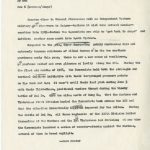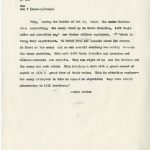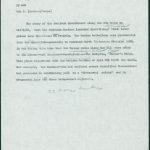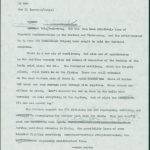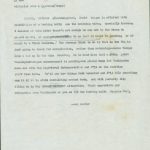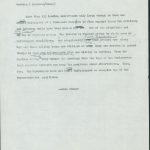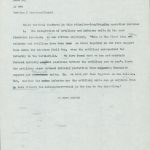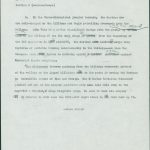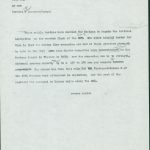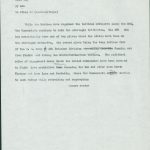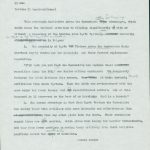1968, October 15-16, “Developments Along Demilitarized Zone”
zczc sag
yy nnm
dmz 1 (normass/deepe)
(This is the first of a two-part series on developments along the demilitarized zone, Vietnam).
WITH THE U. S. THIRD MARINE DIVISION, ALONG THE DEMILITARIZED ZONE, VIETNAM, OCTOBER 1415–The relative balance of forces along the DMZ has turned dramatically in favor of the Allies more clearly than at any other time during the two-year history of American operations here.
At this time, there is no visible evidence nor verbal hints of any Allied withdrawal from the DMZ defense line nor of any large-scale replacement of U. S. Army units for the American Marines, who now hold two-thirds of the 40-mile-long hilly line.
==more reuter
zczc sag
yy nnm
dmz 2 (normass/deepe)
The reasons for the shift in the blan balance of forf forces are obvious and two-fold. First, the Americans simply have more power along and immediately south of the DMZ than at any other time since operatitheir military operations began here in mid-1966. At the beginning of this year, there were two Allied divisions here–one American Marine division and one Vietnamese Army division–in the two northernmost provinces; today there are four divisions–two U. S. Army airmobile divisions having been added in mid-January–plus more armor, riverboats, logistical capabilities and helicopters.
Second, and perhaps more important, the Communist North Vietnamese divisions have virtually disappeared from the area. American Marine commanders here believe they have inflicted such heavy losses on the Communist divisions they have against sought sanctuary out of South Vietnam “to lick their wounds.” American Army commanders say the Marines may be exaggerating their victories–but even they concede the Communists have been substantially weakened in the two northern provinces and are now virtually on the run. One Army senior Army officer, with long-term experience in Vietnam, said, “I just can’t believe how good things look up here for us. I’m almost afraid to talk about it–for fear something will happen to change it.”
==more reuter
zczc sag
yy nnm
dmz 3 (normass/deepe)
Since the beginning of 1968, the Communists have had five main-line divisions, or former divisional entities in the two northern provinces at one time or another–mostly all at the same time during Tet when they employed at two-pronged wa r war ag simultaneously against Hue and Khe Sany Sanh. Now, the Communists maintain only one division–the 320th–along the DMZ, plus three independent regiments–the 27th, xxx 138th and 20 220th. The reman remnants of the other four divisions–308th, 304th, 324B and 325C–have either retreated into North Vietnam, Laos, or, as in the case of 325C, itit has prushed southwards into the Two Corps area, into the Pleiku-Dak To perimeter, after participating in the siege of Khe Sany Sanh.
==more reuter
zczc sag
yy nnm
dmz 4 (normass/deepe)
How long will the Communists continue to fade away along the DM? DMZ? No one is predicting. But high-placed sources say that within a week’s time, North Vietnamese divisions could again mass above the DMZ organize above the DMZ and begin moving southwards. “At this time, the enemy is nearly completely ineffective because we have kept him off-balance all the time,” one senior MARINE officer explained. “But, the enemy has a tremendous replacement capability and this could change within a week’s time. He could bring in other units from the North within a week.”
==more reuter
zczc sag
yy nnm
dmz 5 (normass/deepe)
Sources close to General Creighton W. Abrams, American commander in Saigon, say the Marines have in recent weeks been so successful in confiscating Communist arms, weapons asms, ammunition and food caches inside and immediately south of the DMZ that they have prevented the North Vietnam’s 320th Division from launching mass assaults at Allied positions further south–at such headquarters and supply complexes at Calu, the artillery base at Camp Carroll, the Rockpile area and the Cam Lo district dow town and huge refugee center.
“Now the 320th Division has gone back across the Ben Hai (the river forming the middle boundary of the DMZ) and tim before they come down again they have to set up their whole supply system again,” an officer close to General Abrams said.
–more reuter
zczc sag
yy nnm
dmz 6 (normass/deepe)
Sources close to General Abrams–as well as independent Western military obw observers in Saigon–believe it will take several months–sometime into 1969–before the Communists are able to “get back in shape” and initiate another mass march into South Vietnam.
Compared to the grim, depar depressing grimly depressing days and extremely tenuous existence of Allied forces i in the two northern provinces early this year, there is now a new sense of confidence, p4 profound relief and even glimmers of levity along the DMZ. During the first six months of 1968, the Communists held both the strategic and tactical initiate initiative with their two-pronged pressure points on Khe Sanh and Hue; it wasn’t until their last push ending June 5 with their Third-Phase, positional warfare thrust during the bloody battle of Dai Do, thre two miles north of Dong Ha, that the Marines and Vietnamese First Division hurled the Communists back across the DMZ and that the situation dramatically imprived improved for the Allies. During the Battle of Dai Do, all three regiments of the 320th Division hurled themselves at the Marines and the 1st Vietnamese 1st Division; at one time the Communists launched a series of counter-attacks against the Marines, several of them in broad daylight.
==more reuter
zczc sag
yy nnm
dms
dmz 7 (normass/deepe)
“And, during the battle of Dai Do, while the marnies Marines were assaulting, the enemy stood up in their foxholes, left their holes and assaulted us,” one Marine officer explained. “” “which is very, very significant. We moved from our assault about 150 meters in front of the enemy and as our assault echelong was moving toward the enemy position, this unit left their foxholes and trenches and counter-attacked our assault. They ran right at us and the Marines and the enemy met each other. This requires a unit with a great amount of esprit or else a great fear of their cadre. This is attrition warfare–the enemy attempted to take no repeat no objective; they were simply endeavoring to kill Americans.”
==more reuter
zczc sag
yy nnm
dmz 8 (normass/deepe)
In July, it appeared that the 320th Division was positioning itself to again come across the Ben Hai river–probably sometime in August–but with a series of pre-emptive, spoiling operations, the Ma American and Vietnamese units oper regaining the tactical their-tat tactical initiative by then, forestalled this.
“Now, we’re destroying hus his jumping off points, his caches, command and control control locations, hospitals, springboards and staging areas,” a Marine officer explained. “We’ve also dr destroyed his training ar bunkering systems and training areas. One training area zczczczczmmm The First Battalion of Fourth Marines came across and destroyed a trainingCommunist area they just couldn’t believe, complete with classrooms, and lecturns and blackboards, also safe conduct passes and letter of introduction for histheir students.”
==more reuter
zczc sag
yy nnm
dmz 9 (normass/deepe)
Expectations now are that only in 1969 will the North Vietnamese have replaced their these staging areas and weapons caches sufficiently to make another major push n into South Vietnam.
Now, senior Marine staff officers who in early June described the DMZ in early June as “the closest thing we’ve seen to conventional warfare with organized military formations facing each other, each supported by his own heavy artillery,” now they say “on currently say “on our side the major problem is conveying to the American people we have this war won and we shouldn stay around and negotiate from strength… Hanoi is in such sorry shape they wereit is begging for peace.”
==more reuter
zczc sag
yy nnm
dmz 10 (normass/deepe)
The story of the American involvement along the DMZ began in mid-1966, when the American Marines launched Operations, Hastings, which later glided into Operations Fa Prairie. The Marine battalions were piecemealed into the operation–generally to confront North Vietnamese Division 324B. It was during this time that the famous names along the DMZ were added to the Marine–and American–vocabularies–names such as the Rockpile, and Mudder’s Ridge. This phase culminated with the vicious battles of Hill 881 North and South. But mid-1967, the Marines–who had suffered severe casualties themselves–had succeeded in eliminating 324B as a “divisional entity” and it fragmented into the three independent regiments.
==more reuter
zczc sag
yy nnm
dmz 11 (normass/deepe)
By late 1967, however, two more Communist divisions–304 and 325C–moved into South Vietnam and later gained worled- world-wide attention during the Khe siege of Khe Sanh. This began the darkest days in the history of the DMZ–and further south, in the battle of Hue. I m It may go down in history as one of the most mhie militarily mismanaged periods inxAmm of h the American involvement in Vietnam.
But, by latemid- January one regiment from each of the two divisio Communist divisions around M Khe Sanh–the 24th Regiment of the 204th Division and the 29th Regiment of the 325C Division–had already moved toward Hue, which was by that timeBecame the scene of heavy fighting of the Third Phase, positional warfare variety. These two regiments joined with the 9th 90th indmmmm regiment of the old 324B Division to stop dol cold the U. S. Army 1st Calvary as it sought–but failed–to reinforce the American Marines fighting inside Hue city. There was also heavy contact between the 1st Air Calvary and tw the two other regiments of the old 324B Division==the 812th Regiment, which was turned back from Quang Tri provincial capital and the 803rd Regiment, which strutted striag straight down the “Street Wiht Without Joy” area to reinforce the North Vietnamese inside Hue.
==more reuter
zczc sag
yy nnm
dmz 12 (normass/deepe)
Also, during the Tet offensive, the North Vietnamese 320th Division was targetted against the district town of Cam Lo in Quant Quang Tri province— where the Marines somehow held off their advance southwards.
It was during this hectic period that three Allied diviso divisions–the Third Marine Division, 1 Vietnamese 1st Division, U. S. Army 1st Air Cavalry, aided somewhat by the U. S. Army 101st Airborne, which had been held as a g general reserve–were in vicious contact with major elements of four North Vietnamese divisions–the 320th, 325C, the old 324B and the 304th.
It was not until the end of February that the Allies eva even began to get on top of the situation–when they pushed out the six mainforce Communist re main-force regiments out of Hue, which were then reinforced with numerous autonomous battalions, and troublesome rear guard snipers and assassination squads. These small groups continued to cause trouble and insecurity, and in some cases, executions atrocities in and near Hue until late March.
==more reuter
zczc sag
yy nnm
dmz 13 (normass/deepe)
By mid-March, in the Khe Sanh perimeter, the remants remnants of 325C–which the Marines say had suffered heavy casualties from U. S. firepower during the siege–moved southwards towards tw into the Second Military Corps. The two remaining regiments of the 304th Division were severely routed as th the 1st Air Cavalry and the Marines broke up the siege of Khe Sanh, beginning March 29; these two regiments did not chose setpiece confrontations with the advancing Allies, but simply fled the battlefield, leaving behind more supplies and equipment “than I ever dreamed of,” one Army officer explained.
But, as the two regiments of the 304th fled in April, the Communists reinforced in May with two new regiments of the 308th Division–supposedly to camouflage the withdrawal of the 304th. The Marines say they later knocked out the major effecicombat effectiveness of these two regiments in June in “Operation Robin” where the Communists fought to protect a new roadnet network leading from Laos into South Vietnam, south of Khe Sanh. The two remaining regiments of the 308th have been confirmed much further south in Quang Ngai province, where is hasthey Have been unusually disruptive in recent months.
==more reuter
zczc sag
yy nnm
dmz 14 (normass/deepe)
The 308th North Vietnamese Army Division deserves special mention. Fourteen years ago, it gained fame as part of the Communist forces which forced on the French theira military defeat on the French at Dien Bien Phu in 1954. It was then known for its proficiency in night attacks and for the accuracy of its artillery regiment. Because of its outstanding performance at Dien Bien Phu, the 308th was honored by the Communisg Communist regime by being assigned in Hanoi as the capital garrison. For the past several years, Allied intelligence officers have been watching this elite division, postulating that when the Communists committed theirthis “palace guard” units, they were getting to the end of their military ropes.
WithIn June, the Marines’ beating back the two regiments of the 308th in June on the Laotian flank, while pushingthey mxxm and the Vietnamese pushed back the attacks and counter-attacks of the 302 320th Division in the battle of Dai Do along the DMZ. Since the then, the 320th has by and large remained north of the DMZ Ben Hai river; their attempts to prepare their battlefield for an August “third-wave” offensive seems to have been turned back by aggressive and mobile Allied tactics.
== more reuter
zczc sag
yy nnm
dmz 15 (normass/deepe)
Aginst
Compared to Against this History background Historical back-drop, the DMZ has been relatively free of big-unit confrontations as the Marines and Vietnamese, and the newly-arrived U. S. Army 5th Mechanized Brigade, have sought to hold the tactical momentum.
There is a new air of confidence, but also one of apprehension as the shifting monsoon rains and rumors of cessation of the bombing of the North swirl around the DMZ. The Communist artillery, which has largely silent, still lurks in on two flanks. There are still ambushes on the most western side of Route 9, which caused one where MA Marine tur truck and tank convoys push through with supplies. These caused one officer to groan, “Don’t measure the war up here by who holds what terrain; we hold everything in the daytime, but at night the Communists NVA are all around us.”
The Marines suspect the NVA divisions are now regrouping, refitting and resupply to resupplying for another push into the South. They vow they’ll “We’ll push the CommunistsThem back again. xmxmxmxmxmxmxmjust like we did Before.” Barring political miracles in Paris, the possibility looms of even bloodier fighting sometimes, somewhere–perhaps everywhere–along the demilitarized supposedly demilitarized line.
==more rueter
zczc sag
yy nnm
dmz 16 (normass/deepe)
(Hank: I’ll file the next piece tomorrow. Also, the Saigon press is being squeezed out of the Le May coverage by incoming press and By Le May‘s desire not to have jounr journalists follow him. Anh Anyhow, I’ll try to do something on him, probably afterAS he departs. funnyem Also, if at all possible, I might try to do a coup aftermath piece. I gather the newsmagazinesNewsweek isare doing a recap on it this week. Also, what do you think about theOr do you want [May lead?] in the political series for the last week in October? Regards Bev).
==end router
Part II: Base Hopping
Surrounding the Demilitarized Zone, the Americans constructed small bases in high places as lookout posts. The following article details how they were made and used as fighting continued at the DMZ.
zczc sag DMZ K/S
yy nnm
editorial note 1 (normass/deepe)
SAIGON, OCTOBER 16–Prohayward. Hank: Saigon is aflutter with speculation of a bombing halt; see the incoming wires, especially Reuters. I decided at this point there’s not enough we can add to the wires to go out on it; it seemsinmonmmitmmm to me that it could be genuine, or it could be a trial balloon. Besides, our DMZ stuff seems timely. The strange think to me is that Le Duc Tho is just going to Hanoi for consultation, rather than returning–hence things look a bit up in the air. However, we do hear here that a joing joint Washington-Saigon announcement is pending–so please keeps let Washington come out with the high-level interpretation and I’ll do the reaction stuff from here. We’ll see how things look tomorrow and I’ll file something one it if it is still circulating around town, and will probably skip filing on Le May altogh altoghet altogether. Would appreciate any advisories from Washington or you on thi the bombing halt. Regards Bev).
==end reuter
zczc sag
yy nnm
dmx
tactics 1 (normass/deepe)
(This is the second of a two-part series on developments along the demilitarized zone, Vietnam. As speculation reigns of an American bombing halt just North of the line.).
WITH THE U. S. THIRD MARINE DIVISION, ALONG THE DIMILITARIZED ZONE, VIETNAM, OCTOBER 16–Marine units operating around the former combat base of Khe Sanh have developed unique and highly mobile tactics–helicopter hopscotching along the mountain hilltops.
For roughly thirty miles along the Demilitarized Zone–from the beginning of the northern hill-lands westward toward the Laotian border–the Marines have dotted the tops of razor-back ridgelines and isolated peaks with a whilewhole checkerboard of artillery bases, helicopter landing zones the size of three pingpong tables and bunkered patrol bases, that look like gr igloos of green sandbags tucked away l silhouetting against the jungle.
==more reuter
zczc sag
yy nnm
tactics 2 (normass/deepe)
More than 135 landing zones–some only large enough to land one helict helicopter at a time–and more|than 15 fire support bases for artillery and infantry units have been hacked off the out of the ridgelines and onoff the top of mountain peaks. The terrain is cleared either by chain saws or air-dropped demolitions, and occasionally every Even Random bomb craters are used. Not all these hilltop bases are utilized at one,once; many are vacated by ground troops as they are helicoptered from one hilltop to another. When the Marines leave,A patrol base area, they denude the sandbags from the tops of the bunkers–so that American aircraft can keep the positions under observations. Thus, far, the Communists have not boobt boobytrapped or occupied any of the Marine-created positions.
==more reuter
zczc sag
yy nnm
tactics 3 (normass/deepe)
Some strategic positions are manned constantly–but with a rotation of units from Marine units. Some bases were held by the Marines ssAS observation lock-i look-outs even during the siege of Khe Sanh. One of these bases is atop Hill 950, where minefiled minefields laid by the French, the Communists and the Americans engulf the Marines into an area the size of a football field;. xtaxd Hill 950 is considered strategic because it over-sees the northwest passage for Communist infiltration intoxCommunist from Laos into SVN. Monkey-like animals harrass the mar Marines on Hill 950 by throwing baseball-sized rocks at them; the Marines call them “rock-aps apes.” A wooden platform half the size of a tennis court serves as the helipad; some of the bigger helicopters can land only on their rear wheels, while letting the passengers out the rear gate, as the nose and front wheels of the helicopter it is turned skywardare powered skyward. One helicopter carrying a Marine brigadier general has already crash-landed o at the mini-pad and the officer was returned to the United States for medical care.
The 150-some landing zones and fire support bases have all been given names, several after names after x==moremreuterm former Marine Corps commandants, SUCH AS CATES AND SHEPHARD, several after girls, SUCH AS MARGO AND BECKY, AND several after birds, such as Robin, and Hawker Hawk and Mallard. One is also named Winchester, which caused the Navy chaplain to erect a simple altar amidst the jungled trees near the base and exclaim, “Ah, what could be bt better. Winchester Cathedral! “.
==more reuter
zczc sag
yy nnm
tactics 4 (normass/deepe)
The small hilltops clearings, which take two days to prepare, enable the Marines to employ a sort of shotgun, or splatter-ty-e type of mobility, as distinct from the ground mobility the Marines fin failed to achieve at Khe Sanh before it was besieged by larger Communist formations.
“Since the Khe Sanh siege was lifted,” one senior Marine officer explained, “the Marines have i incr doubled thei their helicopter-lift capabilities up here. The U. S. Army’s last of the 5th Mechanized Brigade has taken over responsibilities along the DMZ near the seacoast. The Marines have large, heavy ground maneuver elements that can defeat the enemyalmosx even when he’s in the mountains and in the jungle, even though he can move from his sanctuari in on ous us from his o sanctuaries in Laos or North Vietnaam.
“The Marines are convinced the only way to keep themEnemy from threatening other points in the populated areas o of Quang Tri province is to move Marines out whevevwherever and whenever we can find the enemy. We concentrationE on finding the enemy from out clour cleared-out landing zones–and then we put Marines in the middle of the enemy.Him. We have cleared and now maintain landing zones all over gh this area. The If a battaliMarine battalion runs out of t enemy and would sometimes isBE more productive elsewhere, the Marines are moved. We move these battalions around helter-skelter. We try to pull back the Marine troops for rest for one or two days out of every eight or nine days–but the main thing for us i is to keep after the enemy.”
==more reuter
zczc sag
yy nnm
tactics 5 (normass/deepe)
Other tactical features in this ridgeline-leapfrogging operation include:
1. The integration of artillery and infantry units in the same frontline location. As one officer explained, “This is the firs time andthe infantry and artillery have been toge so close together in one fire support base since the American Civil War, when the artillery accompanied the infantry to the battlefield. We have found that we can not maintain forward infantry possibl positions without the artillery and we can’t leave the artillery alone without infantry protection from sappers a Communist sappers and main sorceground units. So, we have put them together on one hilltop. But, neither the islox infantry nor the artillery units can go anywhere from v here without the helicopters–which is the key to the operation.”
== more reuter
zczc sag
yy nnm
tactics 6 (normass/deepe)
2. In the three-dimensional jungled terrain, the Marines now are heli-dropped on the hilltops and begin patrolling downwards into the valleys. Tin This is a rather significant change from the past, –Since April withup to the time of the lifting of the Khe Sanh siege.in April. From the beginning of the DMZ operation in 1966 mid-1966, the Marines were heli-bar drops were captives of suitable landing zones–mostly in the valleys–and then the troopers were often forced to marching uphill, il against sometimesoften against Communist dug-in positions.
The difference between marching from the hilltops downwards instead of the valleys up the jagged hillsides andx to the peaks is saving the Marines an incredible amount of time and energy. One l Marine battalion commander pointed out one of his company positions only onlx half mile away on the map–but a tangled,x steep ridgeline away. He said it took his company 14 45 minutes to walk down the hill–but eight hours to wlk walk back up it.
==more reuter
zczc sag
yy nnm
tactics 67 (normass/deepe)
These mobile tactics have enabled the Marines to regain the tactical initiative on the western flank of the DMADMZ. One other helpful factor for them is that the Marine line companies are now at their greatest strength to date in the war; even many Marine companies were understrength even as the Marines landed in Vietnam in 1965; now the companies are up to strength, informed sources report,–up to a 150 to 180 men per company.because only 700 V The reason has been that only 700 Vei Vietnam-veterans f of the 27th Marines were withdrawal in September, and the rest of the regiment was assigned to Marine units along the DMZ.
==more reuter
zczc sag
yy nnm
tactics 8 (normass/deepe)
Further east, on the seaside flank of the DMZ, the introduction of the U. S. Army 5th Mechanized Brigade has also enhanced Allied mobility, there, thus freeing Marines and Vietnamese troops from their bunkered outposts and barbed w barb-wired installations such as at Con Thien. Initial reports indicate that the 5th Mechanized Brigade, which replaced the 27tyth Marines, is having trouble with Communist land mines and ambushes. Some fear the monsoon rains in the sand-dune and shaggy brush environment will further hamper the tanks and other tracked vehicles in the brigade. Already one operation to join up with Marines in the rolling “peidmont” hills into the DMZ has been cancelled, informed sources report, because the Army’s armor could not cope with the terrain.
==more reuter
zczc sag
yy nnm
tactics 9 (normass/deepe)
Like the Communists, the Marines are faced with the two immediate problems–the monsoons and malaria. Malaria is considered far worse a problem for the Communists than it is for the Marines;. Many com Communist prisoners talk of heavy losses to their units because of fevers. But, it is serious for the Marines too. Casualties from the “fever of unkown unknown origin”–which turns out to be malaria 80 per cent of the time–are equal to combat casualties during quiet days of the way. xnotxmmonlymwar. At times, the fevers run so high that Marines are given emergency helicopter evacuation off the frontlines for treatment; there have been several fatalities;. allAll Allied military personnel in the two northern provinces are taking daily supplemental anti-malaria pills, which has resulted in a 50 per cent drop in the casualty rates and lesseneding the seriousness of the disease.
==more reuter
zczc sag
yy nnm
tactics 10 (normass/deepe)
Just how much the monsoon “goo”–as pilots call it–will reduce the Marine mobility, heliborne operations and resupply missions is open to question; commanders say the monsoons will definitely reduce the scale and efficiency of the mobile operations. The northeast monsoons will probably prove less disasterous to the Communists than the outgoing monsoons, which have for the past several months drenched their roads on the Laotian side of the mountains.
==more reuter
zczc sag
yy nnm
tactics 11 (normass/deepe)
One can not but sense the profound irony of the new Marine operations along the DMZ, and the Army operations in the province just south of it, in comparison with previous periods of the war. When the Marines landed in the populated coastal lowlands in 1965, they sought to fight theA counter-insurgency war Against local guerrillas and to secure the local population. They pooh-poohed the Army’s hectic heliborne search-and-destroy operations into the remote, jungled and spare sparesley populated areas. The Marines resisted operating along the DMZ in search of elusive North Vietnamese units–until directly ordered by General William C. Westmoreland in 19 mid-1966. Now, the two services up here have changed roles–with neither the Marines nor the Army seeming to realizing it. Now, in Thua Thien province, the Army’s e two elite, airmobile divisions–the 101st and 1st Cavalry–are in the lowlands and the Army commanders are as enthusiastic about weeding out the Communist “infrastructure” and protecting the local population as the Marines were in 1965. And, the Marine commanders along the DMZ are now enthusiastic about Helicopter operations into Remote areas that they had once criticized the Army for launching.
==more reuter
zczc sag
yy nnm
ta ctics 12 (normass/deepe)
While the Marines have regained the tactical offensive along the DMZ, the Communists continue to hold the strategic initiative. The DM DMZ has consistently been one of two places where the Allies have been on the strategic defensive, the second place being the long defense line of the U. S. Army 45 4th Infantry Division stretching from Ple fanning out from Pleiku and facing the Cambodian-Laotian borders. The political rules of engagement under which the Allied commanders have been ordered to fight have prohibited fromtheir crossing the Ben Hai river into North Vietnam and into Laos and Cambodia, where the Communists scitter skitter to seek refuge while retraining and regrouping.
==more reuter
zczc sag
yy nnm
tactics 13 (normass/deepe)
This strategic initiative gives the Communists thesethe following advantages, which could cause the tactical situation to flipflop significantly wt with or without a cessation of the bombing over North Vietnam, which is— currently widely speculated ona topic of wide speculation in Saigon:
1. The proximity of North Vit Vietnam gives the Communists their shortest supply routes for war materials and their fastest replacement capability.
“I’ll tell you how fast the Communists can replace their casulatie casualties along the DMZ,” one Marine officer explained. “We completely battered the 320th Division this summer, they broke it broke contact, And exfiltrated from South Vietnam. Then the 320th was re-introduced with the same cadre but fresh troops and res re-established contact. All of this happened in 11 days–and to the best of my knowlegdge that is a record.”
2. The second advantage is that from North Vietnam the Communists can employ their tube artillery with more intensity and effectiveness than at any other place from any other place into the South. Their ammunition supply lines are shot shorter, which gives them leeway for heavier bombardments, and they face fewer problems in moving their artillery into their invisible positions inside the sidesentrails of mountains.
==more reuter
zczc sag
yy nnm
tactics 14 (normass/deepe)
It is not only the intensity of ar Communist artillery fire in the past, but also th its accuracy on fixed Marine installsion installations which causes concern among the Marines. During the summer months, Communist artillery fired into the Marines’ huge logistical base of Dong Ha three times. The first round of each barrage hit a prime target. Once, the first round hit a Marines amjuni ammunition dump; on the second barrage, the first round hit a fuel supply point; one the third barrage, the first round hit another ammunition dump.
Marine commanders here recall here that the siege of Khe Sanh began, not with an intense Communist artillery barrage, but with an embarrassingly accurate one–the first roundsShells hit the Marines ammunition dump, which send “hot rounds cooking off” around the Marines for 12 hours. Likewise, one of the first rounds in mid-May against the U. S. Army 1st Air Calvary ignited their American ammunition dumpdepot–which in turn destroyed and damaged more than 1 roughly 100 helicopters.
Marine commanders and troops “just feel” the Communist artillery is being positioned still being positioned in North Vietnam and Laos to “zap” at their “sitting-duck installlon installations. at any time.” Noe one is pirdicri predicting when.it will happen.
==end reuter
Read Previous Article: 1968, October 12, “Orderly, But Strategic Withdrawal”
Read Next Article: 1968, “Attempting to Spark Overthrow”






